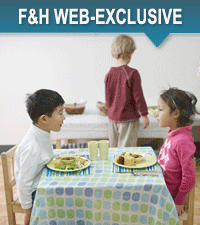Toronto-based contract-caterer feeds kids healthy, tasty meals at competitive prices
It has long been the cry in the educational sector that every child needs access to more nutritious meals throughout the school week, if we, as a nation, are to ensure that the next generation of Canadians grows up healthy, intelligent and happy. The impediment to that has always been budgetary in nature. Sure, we have the means to feed our kids nutritious and sustainable foods, but who’s going to pay for it?
But what if serving kids healthy meals wasn’t that expensive? David Farnell, who co-founded Real Food for Real Kids with his wife Lulu Cohen-Farnell, says it doesn’t have to be. F&H sat down with him to discuss his daycare feeding business and his goal of getting elementary schools in Ontario to buy into the program.
F&H: Tell me a bit about your business.
DF: We are a contract-caterer, focused on kids, that’s been in business for six years. We cater to more than 120 childcare centres, from Pickering to Newmarket to Oakville. The great majority of them are not-for-profit, community-based — the YMCAs, et cetera — but a small number are privately owned. Our focus has been on feeding the kids, regardless of their demographic.
So a lot of them are the ones who need it the most.
That’s exactly what we were thinking when we started. We have contracts with daycare centres that are attached to women’s shelters and in Jane and Finch, as well as ones in Rosedale and the Annex in downtown Toronto. We are all over the map.
The three- and four-year-olds that have grown up on our lunches and moved on to elementary school, their parents have asked us to problem-solve our way into those schools, too. They want to continue with us, for our high quality of food and the convenience, but also because we train palates, which is something many parents are increasingly aware of. We are getting kids to eat vegetables without it being an issue, because it becomes normal for them.
What are the main challenges in taking it from daycare into elementary schools?
The bigger challenge has to do with sanitary requirements at the schools. We do what high-end local restaurants do — we cook from scratch, and we don’t just outsource the cakes to some company. We bake our own breads. It takes a soulful, dedicated, hardworking ownership to not just do bottom-line-driven outsourcing. The large contract-caterers are only about bottom-dollar outsourcing. They’re going to find companies and partners to do stuff for them, using whatever off the grocery-store shelves, or the foodservice versions of what’s on the grocery store shelves, which is batch-produced well in advance, chemically preserved and artificially coloured. We don’t think that way.
Our challenge in the elementary schools is how do we focus on all the value being in the food, and not in the delivery mechanism? The Sodexos and Aramarks are not playing in the elementary school level — they’re only in the high schools, where there are full cafeterias. They are facilities-management companies; they don’t cook so much as reheat food made by industrial food-processing companies.
We have an entirely different reason for being in business. My wife, Lulu, and I are the shareholders. We hold ourselves accountable to the parents and the kids. As a result, we are not just looking to outsource bread to save money; we hold on to the bread, because we want to make gluten-free bread. We hold on to the cookies, because we need to make gluten-free cookies, with low sugar levels. We make everything we can, and if we can’t, because it requires dramatically specialized equipment — like making a tortilla chip — then we will outsource that. But when we do outsource, we’ll make sure the provider meets our same strict guidelines — no artificial colouring, no chemical preservatives, no synthetic ingredients.
Sounds great, but let’s talk about the big question here — feasibility. How are you able to do all this and be competitive on price?
We’ve put some pretty tight constraints on what we offer. You know when businesses always talk about being “customer-focused?” Well, what they really mean is catering to the customer’s whim, or what they think they want — like having 20 different items to choose from every day. We don’t give them that choice. We have smaller, rotating, fixed menus. So, for our childcare segment, which is 90 per cent of the business, there is an a.m. snack for every kid. They can’t opt out of this. That is what’s for the a.m. snack. It’s the same for lunch — period. And that is what’s for the p.m. snack, period.
So there is no choice at all?
There are modifications to some aspects of the meal, if you have allergies or intolerances. We cater to something like 35 different categories of intolerance. But we’re pretty strict on it — the parent has to take their kid to an allergist, because it gets very expensive to make all these changes.
We focus on achieving the maximum scale that we can achieve with every single day’s production. And we can do that because we make it ourselves.
How many meals do you make a day?
We are in the neighbourhood of feeding 5,500 kids. Now, some of those are just snack programs. So, we are making around 5,000 hot-lunch portions a day. We have lots of competitors in the childcare catering sector, and these guys do have thin margins, but the reason for that is that all of the companies competing in the childcare department have price as their only differentiator. They’re not really cooking. They’re reheating processed foods. They have to compete on price.
And also, because they’re buying processed foods — boiling pasta and using sauce out of a can; heating up frozen corn — all they’re doing is adding heat to stuff. Then they put it into containers and ship it. That requires very inexpensive equipment and very low skill. So their labour costs are low and their overheads are relatively low, but their food costs are relatively high.
We have very complex equipment and a manufacturing-size kitchen, because if we have to make 6,000 cookies a day, we can’t do that by hand. There is more than $1.5-million of equipment in the building, and we also have high-skilled labour. Nevertheless, our food costs are at or below our competitors, because we’re buying raw ingredients.
How does that affect the consumer?
For a full day in childcare — which includes a two food-group a.m. snack, a five-element lunch (protein, grain, fruit, veg and milk) and a two food-group p.m. snack — it costs $4.50.
That’s really fair.
It is. So when we get into a discussion about price — say, with a daycare director; one who has been around for a long time — they will know that the next-most expensive caterer is only about 10 or 15 cents cheaper. Now, you can get caterers out there at 10 per cent cheaper, maybe, but everyone is over $4. That’s why we’ve been successful. The name of our game is achieving economies of scale, but also refusing to do things that some people have asked us to do, which we don’t actually think they need — like juice. We also don’t need to provide meat every day.
Give me a few examples of the types of lunches you do.
Because we’re dealing with local suppliers, we get a very good price from our beef supplier. It’s all grass-fed, all-natural, no hormone or antibiotic factory-farmed product. We have no factory-farmed anything coming through the Real Food kitchen. And out of this grass-fed beef, we make an amazing beef barley stew. We get the beef and add in the various spices, which we also grind ourselves, and match that to basmati rice or quinoa, and serve it with broccoli.
How do the kids react to a lunch like that?
I’d say 80 per cent of our menu is very traditional-looking stuff the kids would eat at home. We have a hotdog — but it’s a natural, nitrate-free hotdog from Rowe Farms. We have lots of things people would consider tame for kids, but the quality is much better. But we won’t serve that hotdog on a white bun and with grocery store ketchup. We make our own tomato-sauce-style ketchup and we provide our own pita.
Do you ever solicit their thoughts about what they’re eating?
We do constant surveys of the childcare staff, but we’re not as concerned about the kids loving the food as we are about it being very good for them. It is the parents who are making the decisions for the kids. We make our decisions ahead of time, on contract. So we are insulated a little, and that is one of the benefits to our model.
So 80 per cent of our food is common-looking and tasting stuff. It might be a little bit edgier than what the regular household might do, but we try to encourage those households to tap into the kids’ natural adventurous spirit and curiosity and go further than what you might normally expect a kid to want, because developmentally, they’re ready for it. By the time they hit ages two to four, they’re ready to experience and experiment with more foods. All they need is a smile and some positive encouragement.
The other 20 per cent of our menu does take a bit of an optimistic approach, and is more [about] helping kids discover new stuff. We use red and purple rice, and whole-wheat couscous. We do some Caribbean dishes, Asian, North African and Indian stuff. We have an amazing Sri Lankan curry. And, the best part is, many of the kids in diverse, multicultural neighbourhoods feel that it’s what mom would have made back home. None of our competitors do anything like that.
Do you think a system like yours is something we might eventually see on a province-wide level or even a national level?
I think it is absolutely feasible. I don’t think the change is going to come from the big guys. They are too entrenched. They have big contracts and limitations with skill and equipment. They won’t invest in doing what we do, because they are motivated by the bottom line and not the health and well-being of children. It is going to have to come from small folks. You have to be gutsy and take chances.
F&H: Tell me a bit about your business.
DF: We are a contract-caterer, focused on kids, that’s been in business for six years. We cater to more than 120 childcare centres, from Pickering to Newmarket to Oakville. The great majority of them are not-for-profit, community-based — the YMCAs, et cetera — but a small number are privately owned. Our focus has been on feeding the kids, regardless of their demographic.
So a lot of them are the ones who need it the most.
That’s exactly what we were thinking when we started. We have contracts with daycare centres that are attached to women’s shelters and in Jane and Finch, as well as ones in Rosedale and the Annex in downtown Toronto. We are all over the map.
The three- and four-year-olds that have grown up on our lunches and moved on to elementary school, their parents have asked us to problem-solve our way into those schools, too. They want to continue with us, for our high quality of food and the convenience, but also because we train palates, which is something many parents are increasingly aware of. We are getting kids to eat vegetables without it being an issue, because it becomes normal for them.
What are the main challenges in taking it from daycare into elementary schools?
The bigger challenge has to do with sanitary requirements at the schools. We do what high-end local restaurants do — we cook from scratch, and we don’t just outsource the cakes to some company. We bake our own breads. It takes a soulful, dedicated, hardworking ownership to not just do bottom-line-driven outsourcing. The large contract-caterers are only about bottom-dollar outsourcing. They’re going to find companies and partners to do stuff for them, using whatever off the grocery-store shelves, or the foodservice versions of what’s on the grocery store shelves, which is batch-produced well in advance, chemically preserved and artificially coloured. We don’t think that way.
Our challenge in the elementary schools is how do we focus on all the value being in the food, and not in the delivery mechanism? The Sodexos and Aramarks are not playing in the elementary school level — they’re only in the high schools, where there are full cafeterias. They are facilities-management companies; they don’t cook so much as reheat food made by industrial food-processing companies.
We have an entirely different reason for being in business. My wife, Lulu, and I are the shareholders. We hold ourselves accountable to the parents and the kids. As a result, we are not just looking to outsource bread to save money; we hold on to the bread, because we want to make gluten-free bread. We hold on to the cookies, because we need to make gluten-free cookies, with low sugar levels. We make everything we can, and if we can’t, because it requires dramatically specialized equipment — like making a tortilla chip — then we will outsource that. But when we do outsource, we’ll make sure the provider meets our same strict guidelines — no artificial colouring, no chemical preservatives, no synthetic ingredients.
Sounds great, but let’s talk about the big question here — feasibility. How are you able to do all this and be competitive on price?
We’ve put some pretty tight constraints on what we offer. You know when businesses always talk about being “customer-focused?” Well, what they really mean is catering to the customer’s whim, or what they think they want — like having 20 different items to choose from every day. We don’t give them that choice. We have smaller, rotating, fixed menus. So, for our childcare segment, which is 90 per cent of the business, there is an a.m. snack for every kid. They can’t opt out of this. That is what’s for the a.m. snack. It’s the same for lunch — period. And that is what’s for the p.m. snack, period.
So there is no choice at all?
There are modifications to some aspects of the meal, if you have allergies or intolerances. We cater to something like 35 different categories of intolerance. But we’re pretty strict on it — the parent has to take their kid to an allergist, because it gets very expensive to make all these changes.
We focus on achieving the maximum scale that we can achieve with every single day’s production. And we can do that because we make it ourselves.
How many meals do you make a day?
We are in the neighbourhood of feeding 5,500 kids. Now, some of those are just snack programs. So, we are making around 5,000 hot-lunch portions a day. We have lots of competitors in the childcare catering sector, and these guys do have thin margins, but the reason for that is that all of the companies competing in the childcare department have price as their only differentiator. They’re not really cooking. They’re reheating processed foods. They have to compete on price.
And also, because they’re buying processed foods — boiling pasta and using sauce out of a can; heating up frozen corn — all they’re doing is adding heat to stuff. Then they put it into containers and ship it. That requires very inexpensive equipment and very low skill. So their labour costs are low and their overheads are relatively low, but their food costs are relatively high.
We have very complex equipment and a manufacturing-size kitchen, because if we have to make 6,000 cookies a day, we can’t do that by hand. There is more than $1.5-million of equipment in the building, and we also have high-skilled labour. Nevertheless, our food costs are at or below our competitors, because we’re buying raw ingredients.
How does that affect the consumer?
For a full day in childcare — which includes a two food-group a.m. snack, a five-element lunch (protein, grain, fruit, veg and milk) and a two food-group p.m. snack — it costs $4.50.
That’s really fair.
It is. So when we get into a discussion about price — say, with a daycare director; one who has been around for a long time — they will know that the next-most expensive caterer is only about 10 or 15 cents cheaper. Now, you can get caterers out there at 10 per cent cheaper, maybe, but everyone is over $4. That’s why we’ve been successful. The name of our game is achieving economies of scale, but also refusing to do things that some people have asked us to do, which we don’t actually think they need — like juice. We also don’t need to provide meat every day.
Give me a few examples of the types of lunches you do.
Because we’re dealing with local suppliers, we get a very good price from our beef supplier. It’s all grass-fed, all-natural, no hormone or antibiotic factory-farmed product. We have no factory-farmed anything coming through the Real Food kitchen. And out of this grass-fed beef, we make an amazing beef barley stew. We get the beef and add in the various spices, which we also grind ourselves, and match that to basmati rice or quinoa, and serve it with broccoli.
How do the kids react to a lunch like that?
I’d say 80 per cent of our menu is very traditional-looking stuff the kids would eat at home. We have a hotdog — but it’s a natural, nitrate-free hotdog from Rowe Farms. We have lots of things people would consider tame for kids, but the quality is much better. But we won’t serve that hotdog on a white bun and with grocery store ketchup. We make our own tomato-sauce-style ketchup and we provide our own pita.
Do you ever solicit their thoughts about what they’re eating?
We do constant surveys of the childcare staff, but we’re not as concerned about the kids loving the food as we are about it being very good for them. It is the parents who are making the decisions for the kids. We make our decisions ahead of time, on contract. So we are insulated a little, and that is one of the benefits to our model.
So 80 per cent of our food is common-looking and tasting stuff. It might be a little bit edgier than what the regular household might do, but we try to encourage those households to tap into the kids’ natural adventurous spirit and curiosity and go further than what you might normally expect a kid to want, because developmentally, they’re ready for it. By the time they hit ages two to four, they’re ready to experience and experiment with more foods. All they need is a smile and some positive encouragement.
The other 20 per cent of our menu does take a bit of an optimistic approach, and is more [about] helping kids discover new stuff. We use red and purple rice, and whole-wheat couscous. We do some Caribbean dishes, Asian, North African and Indian stuff. We have an amazing Sri Lankan curry. And, the best part is, many of the kids in diverse, multicultural neighbourhoods feel that it’s what mom would have made back home. None of our competitors do anything like that.
Do you think a system like yours is something we might eventually see on a province-wide level or even a national level?
I think it is absolutely feasible. I don’t think the change is going to come from the big guys. They are too entrenched. They have big contracts and limitations with skill and equipment. They won’t invest in doing what we do, because they are motivated by the bottom line and not the health and well-being of children. It is going to have to come from small folks. You have to be gutsy and take chances.





















